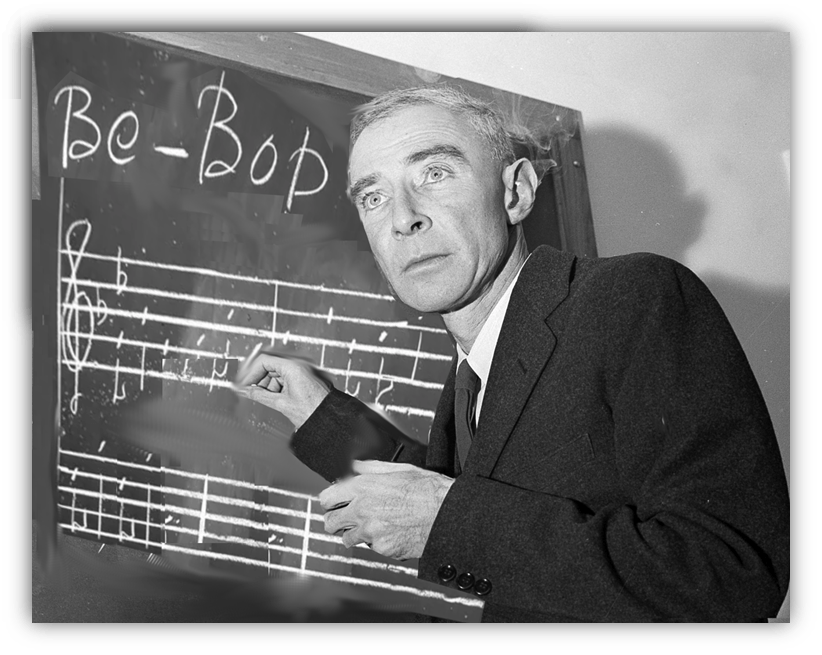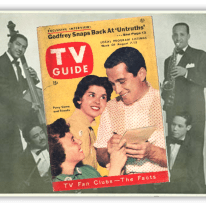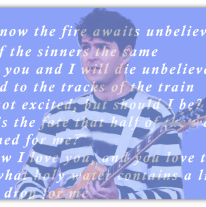In the early 1940s, a new project began in Manhattan, New York.

A small coterie of men met discreetly in obscure locations.
Hidden away from the rest of the world, they began to work on some radical experiments together.

It would take several years of quiet toiling for these pioneers to hone their methods, but by the middle of the decade, their efforts proved to be a terrifying success.
Right around the time that scientists had discovered a way to split the atom, some young upstart musicians had managed to split apart the notion of what “jazz” could be.
Okay, okay, enough hyperbole. Bebop wasn’t quite a disruptor of apocalyptic proportions, but still, nowadays it’s easy to downplay how strange and divisive it was when it first imposed itself upon the jazz world.
Out of Nowhere
“I am invisible, simply because people refuse to see me.”
Ralph Ellison, The Invisible Man
Due to a musicians’ strike waged against recording companies from 1942 to 1945, the development of this new sound is largely left to our imaginations.

The earliest audible snapshots are some poorly recorded after hours sessions from Minton’s Playhouse, one of the clubs that served as an incubator for young side musicians to develop their new style together.
Yet these early recordings sound rather conventional: an intimate, small-band variation on the popular trends of the day.
More notable was a 1942 live recording of alto saxophonist Charlie Parker improvising over a rendition of Ray Noble’s 1938 single “Cherokee.” The original “Cherokee” was a catchy example of the standard swing sound.

Parker’s version starts out faithfully enough, but soon veers into an energetic improvisation, with melodies that flutter above and around the rest of the band.
It’s a style of playing that was influenced by Billie Holiday’s best friend Lester Young, but Parker’s playing is far more energetic and extraverted.
Parker used this performance as the blueprint for his new sound, and in 1945 he released “Ko-Ko,” the first proper recording of what was later called bebop (Parker and others hated that term). Starting with a rhythm played at about twice the tempo of big band swing, the track features Parker unleashing a mad frenzy of notes, honking and squeaking his improvised lines like some hyperactive bird.

When listening to “Ko-Ko,” it’s easy to miss that the band is playing through the chords of “Cherokee,” like that 1942 live rendition. Parker’s playing is so frantic, and so loosely untethered to the chord progressions, that the original song is practically lost in translation.

This was a common feature of bebop: rapid, freewheeling improvisation played over standard blues chords, taking the familiar and transmogrifying it into some strange new creature.
Throughout its many incarnations, jazz had always remained at its heart a form of dance music. But Bird and his compatriots wanted something different. They did not make music to entertain or to move bodies. They wanted serious art for serious people.
From here on out, jazz was head music.

Aside from Charlie Parker, the dignified gents of the new movement included Kenny Clarke and Max Roach, who together turned jazz drumming into its own art form, one focused as much on subtle touches as it was on dramatic flourishes.

- There was Bud Powell, who typified the nimble playing of bebop piano, like a Bird on keys.

- There was also Thelonius Monk, whose cracked playing seemed to borrow as much from modernists like Alban Berg and Scriabin as from Count Basie and James P. Johnson.

- There was John “Dizzy” Gillespie, who redefined the trumpet for the post-war era, replacing Louis Armstrong’s swinging, singsong style of playing with rapid-fire virtuosity.
And there were many others. Including the guy who played trumpet on Parker’s “Ko-Ko” when he was 19. You know the guy. “Miles” something.
Well, You Needn’t
- “I was never more hated than when I tried to be honest.”
Ralph Ellison, The Invisible Man
Langston Hughes, Bop
- “It all sounds like pure nonsense syllables to me.”
Most of the bebop innovators were young musicians who had started out as sidemen in bands led by swing era giants. For instance, Charlie Parker had played with Art Tatum. Dizzy Gillespie had played with Cab Calloway. And both had played together with Earl Hines (alas, not captured on record).
But most of the old guard, those swing era giants… they absolutely hated this new bebop sound when it first emerged. Cab Calloway, Gillespie’s old boss, dismissed it as “Chinese Music.”

Tommy Dorsey was perhaps even less subtle, calling it “Communist Jazz.”
And Louis Armstrong, the living legend, the man who had embraced every variation of jazz that had emerged since its birth, he called it “that out-of-the-world music, that pipe-dream music, that whole modern malice.”
A few years later, Louis took his beef with bebop to live television.

Following an introduction detailing how jazz was once misunderstood but eventually proved to be an essential part of American culture, Louis performed a variation of “The Whiffenpoof Song” that painted beboppers like Bird and Dizzy as out of tune and out of touch:
Black sheep who had gone astray. Certainly not his most generous moment.
In all fairness, Armstrong’s description of bebop as “modern malice” likely has much to do with the bebop musicians’ own blunt rejection of him and what they thought he stood for.
Armstrong was born in the slums of New Orleans in 1901, and he rose to fame by navigating a cultural milieu that many young black men and women in the 1940s found deeply offensive to their sense of dignity.
When Louis took part in the 1949 Mardi Gras parade dressed as the King of the Zulus, they did not think of it as Armstrong proudly taking part in the local African American traditions of his New Orleans community.

They saw it as blackface, as degrading minstrelsy. Quoth Dizzy Gillespie: “Louis is the plantation character that so many of us younger men resent.”
Gillespie and others would later express regret for being so hard on Armstrong. But at the time they saw his cheerful attitude as subservience to white supremacists, something this new generation would not tolerate.

Ironically, having cut his teeth in Cab Calloway’s band, Dizzy himself was the rare bopper who cared at all about entertainment and broader appeal:
The only one who lightened up his seriously impressive playing with doses of levity and humor. And as a result, Miles Davis even threw him in as part of that older minstrel tradition.
No matter what the cutoff point may be, jazz for the new generation was to be serious, dignified, and unconcerned with the white mainstream.
Wail
“Through all of this time of my life, I really was dead—mentally dead. I just didn’t know that I was.”
Malcolm X reflecting on 1945 Harlem
“Nonsense, nothing!” cried Simple. “Bop makes plenty of sense.”
“What kind of sense?”
“You must not know where Bop comes from.”
“I do not know,” I said. “Where?”
“From the police…”
– Langston Hughes, Bop
In fairness to the beboppers, American life in the 1940s and 50s provided plenty for them to be angry about. In the months following the war, when Black veterans returned to their homes, lynchings spiked around the country.

After fighting overseas in the name of freedom, African American men had to face a nation that still looked upon them as lesser beings.
In the cities, young black men and women were often stopped and harassed by white police officers suspicious of their self-confident demeanors. The stops often led to searches, which sometimes led to arrests for the possession of drugs.

For musicians, this meant restrictions on their ability to play clubs and make a living.
Drugs were indeed a growing problem in the jazz world. Heroin was a few decades older than jazz, but its prominence skyrocketed once the mafia turned to alternative sources of profit following the end of Prohibition.
In the US, the Italian mafia provided assistance in the war effort, and later helped to break leftist union strikes.

In turn, the FBI turned a blind eye to their resurgence in the mid-40s, and did nothing to stop the mass smuggling of heroin into city neighborhoods. Other than jailing black men and women for sale and possession, that is.
Beyond prison, this injection of hard drugs into the cities provided frustrated black youths with an easy path to self-annihilation.
Charlie Parker was an early casualty of this new epidemic. He died in 1955 of cirrhosis of the liver, due to years of heroin and alcohol abuse.

Dead at only 34 years, he was estimated by the coroner to be between 50 and 60 years of age due to his poor physical condition.

His death wasn’t the first tragedy in the history of jazz, but it heralded a rising wave that would come to cut many more lives short.
Sure Thing
“This is your home, my friend, do not be driven from it; great men have done great things here, and will again, and we can make America what America must become.”
James Baldwin, The Fire Next Time
As strange as bebop had seemed at the time, it proved to be much more than a passing fad, much as Louis would have liked it to be.
By the early 1950s, most of the brash young musicians had softened their styles a bit, making the rhythms less jittery or the melodies less busy.

Parker released a romantic album with string accompaniment.
Miles Davis, Chet Baker, and others developed a “cool” sound that brought Lester Young’s introversion back into the lexicon, and then some.
By the end of the decade, the bebop sound and attitude had become an integral part of jazz culture. Jazz was freer now, more adventurous, more serious, and more thoughtful.

Once misunderstood, bebop is now embraced as an important component of American and global culture.
But Louis didn’t get it all wrong.
The success of bebop in the jazz world never got anywhere close to matching the success of swing music as a national phenomenon. Just as Schoenberg could never gain crowds like Beethoven did, the heroes of modern jazz would speak only to audiences who could meet them on their terms.

Bebop was still more pop art than avant garde, but it inspired jazz artists to get ever wilder and more confrontational in subsequent decades, all in the name of freedom.
Despite – or perhaps because of their greater personal freedom, modern jazz figures would have far less power to change the public’s hearts and minds than previous jazz icons. They would also have far less interest in doing so.

In the decades to come, jazz would soon no longer be the music of the people – it would be the music of a self-styled cultural elite.
These innovations kickstarted by bebop would cause ripples in the culture far beyond the realm of music. Soon, the best minds of their generation would pursue a shared urge to be destroyed by their madness.
Angel-headed hipsters of all colors would seek angry fixes, and burn for that ancient heavenly connection to the starry dynamo in the machinery of night.

While the rest of the nation would look elsewhere for songs to sing and dance to.
As for bebop itself, I’d say it proved to be a fine enough template for cultural change.
Even if they turned down the chance for superstardom, the musicians managed to be challenging yet flexible, adventurous yet exciting, intellectual but still tied in some way to popular culture.
Their anger wasn’t malice after all, though perhaps they helped set up conditions for future problems to manifest.
But I’m getting ahead of myself. That’s a story for the fire next time…
Let the author know that you liked their article with a “Green Thumb” Upvote!





Damn, I wish I would have thought to fit in a “Boppenheimer” joke. mt beat me to it!
Dumb luck on my part at 2 AM.
As the saying goes: even a broken uranium fissile sphere timekeeper circuit is right twice a day.
Inspired improvisation in the wee wee hours is what this post is about.
Atta eclectic music and art historian.
The historical, racial and political backdrop that you include here is key to understanding the rise of bebop and what it meant at the time. It’s something that was emphasized very little or not at all in the places where I learned about it, so I appreciated that aspect of the article in particular and gleaned much from it. Anytime ones eyes can be opened to the bigger picture, ’tis a good thing!
Agreed!
For people unfamiliar with Langston Hughes’ Bop, here is a more extended passage:
“You must know know where Bop comes from,” said Simple, astonished at my ignorance.
“I do not know,” I said. “Where?”
“From the police,” said Simple.
“What do you mean, from the police?”
“From the police beating Negroes’ heads,” said Simple. “Every time a cop hits a Negro with his billy club, that old club says, ‘BOP! BOP!…BE-BOP! MOP! BOP!” That Negro hollers, “Ooooool-ya-koo! Ou-o-o!” Old Cop just keeps on, ‘MOP! MOP! BE-BOP! MOP!”
That’s where bebop came from, beaten right out of some Negro’s head into them horns and piano keys that play it. Do you call that nonsense?
“If it’s true, I do not,” I said.”
Fascinating. Back when I started the “What Makes…” series (at thegue’s request), I covered all of Jazz in a single article. I need to go back and do one on Be Bop, another on Fusion, another on Smooth Jazz, etc. There are lots of great, interesting, intricacies that I left out. Same goes for Blues and Country and probably a lot of the early articles. I’m afraid there’s no end to the minutiae we can go into. Sorry everyone.
The oppression of African Americans is unforgivable. Yes, we got great art out of it, but we as a country should be ashamed of ourselves. This November, and every election, vote.
“I’m afraid there’s no end to the minutiae we can go into.
Sorry everyone.You’re welcome everyone!”FTFY 😎
“The oppression of African Americans is unforgivable. Yes, we got great art out of it, but we as a country should be ashamed of ourselves. This November, and every election, vote.”
Profoundly important.
Please Be Like Bill.
He’s got my vote 🗳
I’m assuming that my contributions to tnocs come with privileges that allow me to cast my vote.
We’ll be having one of our own and likely around the same time so I’ll be doing my public duty in order to try and counteract the ever divisive and rightwards direction of the incumbents.
I know the names and bits and pieces of these stories but nice to have things fleshed out and given extra context. I hadn’t thought about the way that Bebop took jazz away from a mainstream medium to one that allowed freedom of expression and therefore giving them artistic control. With the audience being a secondary concern. It’s always worth remembering that while jazz may be on the margins now in the rock and pop era, that it wasn’t always so.
One thing that sticks out is mention of the musicians strike lasting 3 years. Given what else was going on in the world people had bigger issues to worry about but even so, losing access to any new music as a way to forget about your troubles seems astounding that it could go on so long.
I dream about those sessions with Bird and Diz in Earl Hines’ band. And with Sarah Vaughan doing vocals! The gods are cruel.
Fascinating stuff, as always!
I’ve been made aware of the Mafia-World War II connection in just the last week (more serendipity!). And it gives The Godfather‘s Michael Corleone/war hero angle some added mystique. What exactly did he do over in Europe (I assume that’s where he was, anyway)? Or did I miss something?